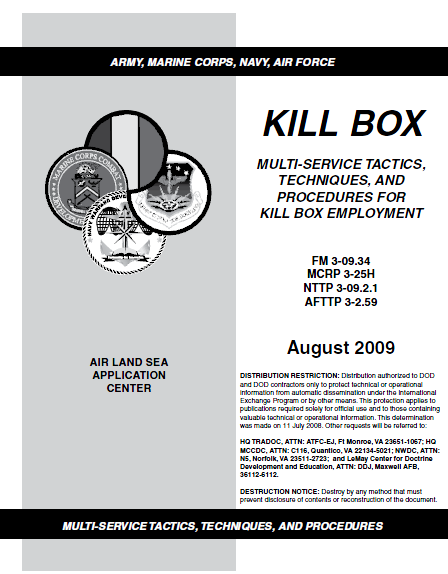The 2005 version of this manual was previously published WikiLeaks.
KILL BOX: MULTI-SERVICE TACTICS, TECHNIQUES, AND PROCEDURES FOR KILL BOX EMPLOYMENT
- 76 pages
- August 2009
The Kill Box MTTP reinforces kill boxes as three-dimensional areas used to facilitate the integration of joint fires while also being a permissive fire support coordination measure (FSCM) in accordance with JP 3-09, Joint Fire Support. The publication offers a detailed explanation of kill box employment and provides information to effectively organize, plan, and execute kill box procedures.
The purpose of this publication is to provide planners and operators with a single source MTTP manual that focuses on employment of kill boxes at the operational and tactical levels of warfighting to facilitate the expeditious air-to-surface lethal attack of targets which may be augmented by or integrated with surface-to-surface indirect fires. The target audience includes commanders, operations and intelligence sections of Service components, and their counterparts on the JFC’s staff.
…
1. Definition and Purpose
a. Definition: A kill box is a three-dimensional area used to facilitate the integration of joint fires. It is a permissive FSCM as described in JP 3-09, Joint Fire Support.
b. Purpose: When established, the primary purpose of a kill box is to allow lethal attack against surface targets without further coordination with the establishing commander and without terminal attack control. When used to integrate air-to-surface and surface-to-surface indirect fires, the kill box will have appropriate restrictions. The goal is to reduce the coordination required to fulfill support requirements with maximum flexibility while preventing fratricide.
Note: All aircrew conducting air interdiction within the confines of a kill box will execute their mission in accordance with rules of engagement (ROE) and special instructions (SPINS) applicable to air interdiction.
2. Establishment
a. Supported component commanders, acting on JFC authority, establish and adjust kill boxes in consultation with superior, subordinate, supporting, and affected commanders. Requirements for kill boxes and other control measures are determined using normal component targeting and planning processes and are established and approved by commanders or their designated staff (e.g., G-3, fire support coordinator [FSCOORD]). Information about the type, effective time, duration, and other attributes will be published and disseminated using existing voice and digital command and control (C2) systems. Kill boxes should be canceled when no longer needed.
b. There are two types of kill boxes: blue and purple. Chapter 3 provides further details.
(1) Blue Kill Box. A blue kill box permits air interdiction in the kill box without further coordination from the establishing headquarters (HQ).
(2) Purple Kill Box. A purple kill box permits air interdiction in the kill box without further coordination from the establishing HQ while allowing land and maritime component commanders to employ surface-to-surface indirect fires. The end state is maximum use of joint fires within the kill box to create synergistic effects with maximum potential for engaging targets.
c. Kill box characteristics:
(1) Target Area. The location and size of the kill box are determined by the expected or known location of targets in a specified area. The dimensions of a kill box are normally defined using an area reference system (i.e., Global Area Reference System [GARS]) but could follow well defined terrain features or be located by grid coordinates or by a radius from a center point. The standard dimensions using GARS would be a cell (30 minute (min) by 30 min [approximately (approx) 44 kilometer (km) by 44km] area), quadrant (15 min by 15 min [approx 22km by 22km] area), or keypad (5 min by 5 min [approx 7.5km by 7.5km] area). Reference JP 2-03, Geospatial Intelligence Support to Joint Operations, for further information concerning GARS.
(2) Airspace. The airspace block located above the kill box target area is protected and extends from the surface (or coordinating altitude if established) up to a ceiling established by the airspace control authority. The airspace for a purple kill box includes a floor and a ceiling to enable separation between aircraft delivering air-to-surface fires, trajectories of surface-to-surface indirect fires, surface-to-air fires, and other aircraft. The height of the ceiling should be established in the Airspace Control Plan (ACP), Airspace Control Order (ACO), or SPINS to permit standardized planning for other airspace uses. These parameters are developed by coordination between fire support and airspace organizations.
…


